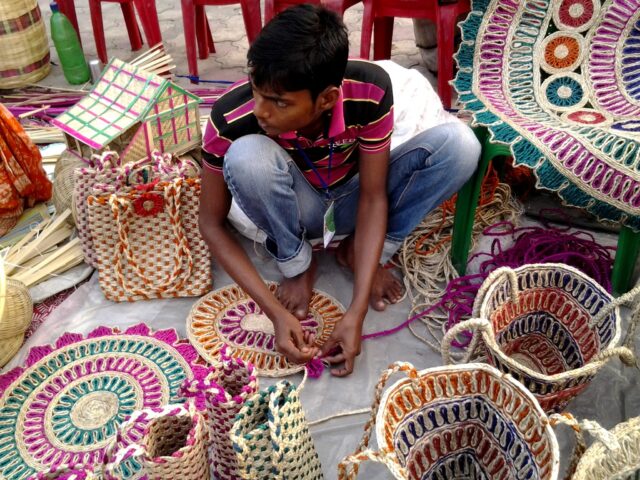Agra, a city renowned for its rich cultural heritage and exquisite handicrafts, has the potential to elevate its artisans and craftsmen on a global stage through effective website development. The internet has transformed how businesses operate, allowing artisans to reach a wider audience and showcase their unique creations. In this blog, we will explore the pivotal role of website development in promoting Agra’s handicrafts online, highlighting its benefits and strategies for success.

Table of Contents
Toggle1. Creating an Online Portfolio
A professionally designed website serves as a digital portfolio, allowing artisans to showcase their handicrafts in a visually appealing manner.
Key Features:
- High-Quality Images: Displaying high-resolution images of products helps capture the intricate details of each piece, making them more appealing to potential buyers.
- Detailed Descriptions: Providing thorough descriptions, including materials used, crafting techniques, and the story behind each piece, adds value and context for customers.
2. Enhancing Visibility and Reach
Website development enables artisans to expand their reach beyond local markets, connecting with potential customers globally.
Visibility Strategies:
- Search Engine Optimization (SEO): Implementing SEO best practices helps improve search rankings, making it easier for potential customers to discover Agra’s handicrafts.
- Local SEO: By optimizing for local searches, artisans can attract tourists and visitors looking for authentic Agra handicrafts.
3. Facilitating E-Commerce
With a robust e-commerce platform integrated into their websites, artisans can sell their handicrafts directly to consumers, bypassing middlemen and increasing profit margins.
E-Commerce Benefits:
- Secure Payment Gateways: Offering secure and diverse payment options builds trust and encourages customers to make purchases.
- Shopping Cart Features: An easy-to-navigate shopping cart enhances the user experience, making it simple for customers to browse and purchase products.
4. Building a Strong Brand Identity
A well-developed website helps artisans establish and promote their unique brand identity, differentiating them in a competitive market.
Branding Elements:
- Consistent Visual Identity: Using a consistent logo, color scheme, and typography across the website reinforces brand recognition.
- About Us Page: Sharing the artisans’ stories, their craftsmanship journey, and the cultural significance of their work creates a personal connection with customers.
5. Engaging Customers with Content
A website provides a platform for artisans to engage with customers through various content types, enhancing their connection with the audience.
Content Strategies:
- Blogging: Regular blog posts about the history of Agra’s handicrafts, crafting techniques, or artisan spotlights can attract and engage visitors.
- Social Media Integration: Linking social media profiles allows customers to follow artisans, fostering community and ongoing engagement.
6. Showcasing Customer Testimonials
Displaying customer reviews and testimonials on a website can significantly enhance credibility and encourage new buyers to make purchases.
Trust-Building:
- User Reviews: Featuring positive feedback from previous customers builds trust and reassures potential buyers about the quality of the products.
- Case Studies: Sharing stories of satisfied customers and their experiences can further promote the brand.
7. Facilitating Communication
A well-developed website can include contact forms, chat features, or social media links, making it easy for customers to reach out with inquiries.
Customer Support:
- Live Chat Options: Providing real-time assistance through live chat can enhance customer service and address concerns promptly.
- Contact Information: Clear and accessible contact information helps build trust and encourages communication.
8. Promoting Cultural Heritage
Through effective website development, artisans can educate customers about the cultural significance of their handicrafts, enhancing appreciation and value.
Educational Content:
- Cultural Narratives: Including stories and history related to specific handicrafts can help customers understand the craftsmanship and cultural heritage behind the products.
- Video Demonstrations: Showcasing the crafting process through videos can captivate audiences and highlight the skill involved.
9. Analyzing Visitor Behavior
Website analytics tools enable artisans to track visitor behavior, providing valuable insights into customer preferences and trends.
Data Utilization:
- Visitor Tracking: Understanding which products attract the most attention can inform inventory and marketing strategies.
- Feedback Mechanisms: Implementing feedback forms can help gather customer opinions and suggestions for improvement.
10. Adapting to Market Trends
A responsive website allows artisans to quickly adapt to changing market trends and consumer preferences, ensuring they stay competitive.
Agile Strategies:
- Seasonal Promotions: Highlighting seasonal crafts or special promotions on the website can attract more customers during peak shopping periods.
- New Arrivals Section: Regularly updating the website with new products keeps the content fresh and encourages repeat visits.
Conclusion
In conclusion, website development plays a crucial role in showcasing Agra’s handicrafts online, enabling artisans to reach a broader audience and increase sales. By creating an engaging and visually appealing online presence, artisans can build a strong brand identity, enhance customer engagement, and promote their rich cultural heritage. Investing in effective website development is not just a technical necessity; it is a strategic move that can significantly contribute to the growth and success of Agra’s handicraft industry. Embracing the digital landscape will empower artisans to thrive in an increasingly competitive market while preserving and promoting their unique cultural heritage.


No responses yet